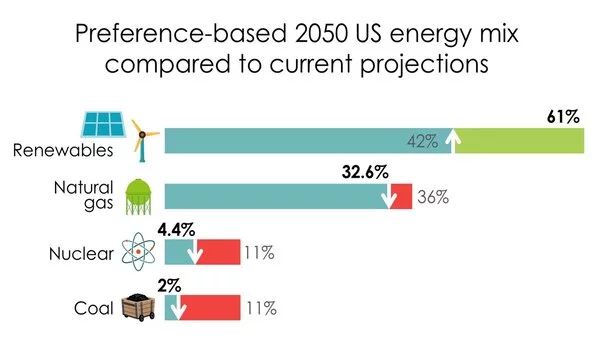Researchers created a ‘desirable’ electricity generation mix for 2050 that includes 50 percent more energy from renewables than current projections by taking into account the demographics and preferences of US racial groups, as clarified by a nationally representative survey of 3,000 US residents. Combining such bottom-up input with top-down energy system goals established by policymakers could help meet both population needs and preferences, as well as emission and climate goals.
As policymakers around the world strive to reduce carbon emissions and meet climate goals, new research identifies a critical group whose views could help shape energy planning for the better: consumers.
Researchers led by Kyushu University developed a ‘desirable’ electricity generation mix for 2050 that includes 50 percent more energy from renewable sources than projections based on current plans and policies, based on demographics and preferences of US racial groups clarified through a nationally representative survey of 3,000 US residents.
“In the United States, consumers are being given more and more options for choosing their energy provider, so listening to and understanding these voices is critical,” says Andrew Chapman, associate professor and study leader at Kyushu University’s International Institute for Carbon-Neutral Research (I2CNER).
In the United States, consumers are being given more and more options for choosing their energy provider, so listening to and understanding these voices is critical. In light of this, we set out to develop an energy plan that incorporates the broad range of voices and the rapidly shifting demographics of the US and then compared it with the current top-down plan in which energy goals are set by policymakers.
Andrew Chapman
“In light of this, we set out to develop an energy plan that incorporates the broad range of voices and the rapidly shifting demographics of the US and then compared it with the current top-down plan in which energy goals are set by policymakers.”
The international team of researchers from Kyushu University, Nagasaki University, and the University of Illinois at Urbana-Champaign surveyed 3,000 people in the United States in 2020 about their preferences, awareness, priorities, and other opinions about energy technologies, policies, and issues in order to develop their energy plan.
They allocated roughly 2.4 billion kWh of electricity generating capacity out to the year 2050 based on the preferences of each racial group and the predicted future racial demographics of the country, taking into account only future construction projects needed to replace power plants at the end of their life and to meet predicted growth in energy consumption.
The resultant energy mix includes nearly 61% renewable-based electricity compared to 42% envisaged under the projected 2050 energy mix according to the US Energy Information Administration based on current plans and policies.

On the other hand, nuclear power is reduced by over half and coal-based generation by over three quarters in the researchers’ plan compared to the projections. Natural gas is similar in both cases, indicating that consumers are aware of the practical need for a stable energy supply.
“There appears to be strong support for a further emphasis on technologies that will help to achieve emission and climate goals when planning the future energy system, as indicated by a strong desire to move away from fossil and nuclear toward renewables,” notes Chapman.
“Though each racial group prefers different sources in the future energy mix, all groups recognize the need for a stable energy supply, combining natural gas with their preference for renewables, led by solar and wind.”
Regional preferences were also revealed. For example, on the west coast, the importance of dealing with climate change and achieving an equitable energy system was significantly higher. In the future, such input could be used to shape energy plans that leverage power grid divisions across the United States.
The researchers note that their plan’s allocation of hydroelectric and geothermal generation may be unrealistic due to the time it takes to plan and implement such projects. Furthermore, respondents consistently identified a healthy economy as one of their top priorities, implying that balancing costs and job opportunities must be factored into energy system design.
“In addition to consumer preferences appearing to favor more renewables than current plans, we discovered that preferences were linked to awareness, which is also strongly linked to education,” Chapman says. “As a result, energy education is likely to be another important factor in meeting carbon reduction targets and encouraging participatory energy system design.”





